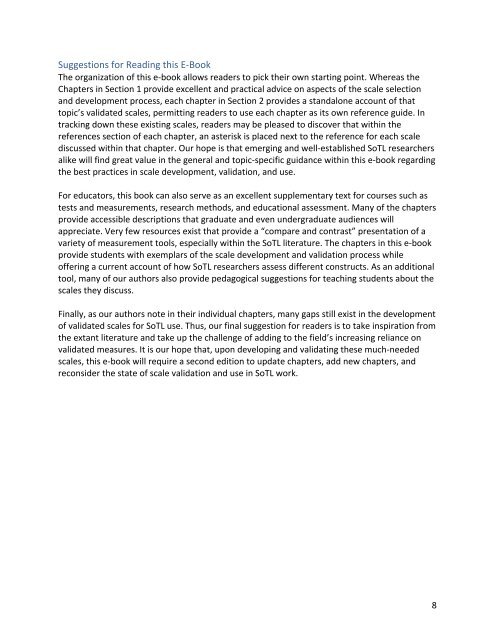A COMPENDIUM OF SCALES for use in the SCHOLARSHIP OF TEACHING AND LEARNING
compscalesstl
compscalesstl
You also want an ePaper? Increase the reach of your titles
YUMPU automatically turns print PDFs into web optimized ePapers that Google loves.
Suggestions <strong>for</strong> Read<strong>in</strong>g this E-Book<br />
The organization of this e-book allows readers to pick <strong>the</strong>ir own start<strong>in</strong>g po<strong>in</strong>t. Whereas <strong>the</strong><br />
Chapters <strong>in</strong> Section 1 provide excellent and practical advice on aspects of <strong>the</strong> scale selection<br />
and development process, each chapter <strong>in</strong> Section 2 provides a standalone account of that<br />
topic’s validated scales, permitt<strong>in</strong>g readers to <strong>use</strong> each chapter as its own reference guide. In<br />
track<strong>in</strong>g down <strong>the</strong>se exist<strong>in</strong>g scales, readers may be pleased to discover that with<strong>in</strong> <strong>the</strong><br />
references section of each chapter, an asterisk is placed next to <strong>the</strong> reference <strong>for</strong> each scale<br />
discussed with<strong>in</strong> that chapter. Our hope is that emerg<strong>in</strong>g and well-established SoTL researchers<br />
alike will f<strong>in</strong>d great value <strong>in</strong> <strong>the</strong> general and topic-specific guidance with<strong>in</strong> this e-book regard<strong>in</strong>g<br />
<strong>the</strong> best practices <strong>in</strong> scale development, validation, and <strong>use</strong>.<br />
For educators, this book can also serve as an excellent supplementary text <strong>for</strong> courses such as<br />
tests and measurements, research methods, and educational assessment. Many of <strong>the</strong> chapters<br />
provide accessible descriptions that graduate and even undergraduate audiences will<br />
appreciate. Very few resources exist that provide a “compare and contrast” presentation of a<br />
variety of measurement tools, especially with<strong>in</strong> <strong>the</strong> SoTL literature. The chapters <strong>in</strong> this e-book<br />
provide students with exemplars of <strong>the</strong> scale development and validation process while<br />
offer<strong>in</strong>g a current account of how SoTL researchers assess different constructs. As an additional<br />
tool, many of our authors also provide pedagogical suggestions <strong>for</strong> teach<strong>in</strong>g students about <strong>the</strong><br />
scales <strong>the</strong>y discuss.<br />
F<strong>in</strong>ally, as our authors note <strong>in</strong> <strong>the</strong>ir <strong>in</strong>dividual chapters, many gaps still exist <strong>in</strong> <strong>the</strong> development<br />
of validated scales <strong>for</strong> SoTL <strong>use</strong>. Thus, our f<strong>in</strong>al suggestion <strong>for</strong> readers is to take <strong>in</strong>spiration from<br />
<strong>the</strong> extant literature and take up <strong>the</strong> challenge of add<strong>in</strong>g to <strong>the</strong> field’s <strong>in</strong>creas<strong>in</strong>g reliance on<br />
validated measures. It is our hope that, upon develop<strong>in</strong>g and validat<strong>in</strong>g <strong>the</strong>se much-needed<br />
scales, this e-book will require a second edition to update chapters, add new chapters, and<br />
reconsider <strong>the</strong> state of scale validation and <strong>use</strong> <strong>in</strong> SoTL work.<br />
8


